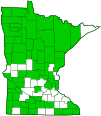common water hemlock
(Cicuta maculata var. maculata)
Conservation • Wetland • Description • Habitat • Ecology • Use • Distribution • Taxonomy
Description |
||
Common water hemlock is a 2′ to 7′ tall, erect, perennial forb that rises on one or more stems from several fleshy, tuberous roots. The foliage has a foul smell. The stems are erect, unbranched or branched at the top, stout, hairless, hollow, and often covered with a whitish, waxy bloom (glaucous). They may be green or purple. Mature stems are green with purple spots or stripes. The base of the stem is enlarged. The main stem leaves are alternate and are divided into 3 segments (ternate). Each segment may be again divided into 3 sections (biternate). Each ultimate section is divided into usually 3, sometimes 5 leaflets (pinnate). The lower leaves are up to 18″ long and 8″ wide, becoming progressively much smaller as they ascend the stem. The uppermost leaves are sometimes undivided. The leaves are on 4″ to 12″ long leaf stalks, longest near the bottom of the stem, shorter near the top. The leaf stalks form a sheath at the base that wraps around the stem. The leaf nodes are purplish. The leaflets are narrowly lance-shaped, 1″ to 5″ long, ¼″ to 1½″ wide, and hairless. They are often folded upward along the main vein. The margins have sharp, forward-pointing teeth. The leaflet nodes are purplish. The radial veins of the leaflet extend to the notches between the teeth, not to the tips of the teeth as in other members of the carrot family. The main leaflets of the middle and upper leaves are less than 5 times as long as wide. The inflorescence is a compound umbel at the end of the stem and each branch. The umbels are round and 1½″ to 5″ in diameter. They are composed of 10 to 20 umbellets. They are not subtended by bracts. The umbellets are on stalks (rays) 2″ to 2⅜″ long. Each one has 14 to 27 individual flowers on stalks (raylets) up to 1⅛″ long. The flowers are about ⅛″ wide with 5 white, rounded, erect to spreading petals and 5 white stamens. The petals are notched at the tip. The fruit is dry, dark brown to reddish-brown, 1 ⁄16″ to ⅛″ long, broadly oblong-eliptic, and flattened laterally. It contains 2 seeds and when ripe splits into 2 one-seeded segments. Each segment (mericarp) has 5 ribs: an upper (dorsal) rib; two lateral ribs; and between each lateral rib and the dorsal rib, an intermediate rib. The ribs are blunt and somewhat corky. The dorsal and intermediate ribs are smaller than the lateral ribs and are as wide or wider than the space between the ribs. The lateral ribs are smaller than the oil tube. The seeds are flattened on one side, rounded on the other. |
||
Height |
||
2′ to 7′ |
||
Flower Color |
||
White |
||
Similar Species |
||
In water hemlocks the radial veins of each leaflet extend to the notches in the leaflet margin, not to the tips of the teeth as in other members of the carrot family. Bolander’s water hemlock (Cicuta maculata var. bolanderi) mericarp dorsal and intermediate ribs are much narrower than the space between the ribs. The lateral ribs are larger than the oil tube. Bulbet-bearing water hemlock (Cicuta bulbifera) has bulbils at the leaf axils of some of the upper leaves. Spotted water hemlock (Cicuta maculata var. angustifolia) main leaflets of the middle and upper leaves are narrower, more than 5 times as long as wide. The fruit is almost globe-shaped, not oblong. |
||
Habitat |
||
Wet to moderate moisture. Meadows, woods, marshes. |
||
Ecology |
||
Flowering |
||
June to August |
||
Pests and Diseases |
||
|
||
Toxicity |
||
Spotted water hemlock is the most poisonous plant in Minnesota and may be the most poisonous plant in all of North America. All parts of the plants are toxic, but the tuberous roots, swollen lower stems, and all new growth are especially toxic. |
||
Use |
||
|
||
Distribution |
||||
|
Sources MNTAXA recognizes only one variety, var. maculata, in Minnesota, and shows all occurences of the species as belonging to that variety. The map at left does not include MNTAXA data. |
|||
| 2/27/2023 | ||||
Nativity |
||||
Native |
||||
Occurrence |
||||
Very common Of the three varieties of Cicuta maculata found in Minnesota, var. maculata is by far the most common. |
||||
Taxonomy |
|||
| Kingdom | Plantae (Plants) | ||
| Subkingdom | Pteridobiotina | ||
| Phylum | Tracheophyta (Vascular Plants) | ||
| Class | Magnoliopsida (Dicots) | ||
Order |
Apiales (Carrots, Ivies, and Allies) | ||
| Suborder | Apiineae | ||
Family |
Apiaceae (carrot) | ||
| Subfamily | Apioideae | ||
| Tribe | Oenantheae | ||
Genus |
Cicuta (water hemlocks) | ||
| Species | Cicuta maculata (spotted water hemlock) | ||
Synonyms |
|||
Cicuta curtissii Cicuta maculata var. curtissii Cicuta mexicana |
|||
Common Names |
|||
common water hemlock |
|||
Glossary
Biternate
Twice ternate. A leaf divided into 3 segments, with each segment divided into 3 leaflets.
Bract
Modified leaf at the base of a flower stalk, flower cluster, or inflorescence.
Compound leaf
A leaf that is divided into leaflets, each leaflet having the general appearance of a leaf, with all leaflets attached to a single leaf stem.
Glaucous
Pale green or bluish gray due to a whitish, powdery or waxy film, as on a plum or a grape.
Mericarp
The split, usually one-seeded portion of a dry, multi-seeded fruit.
Node
The small swelling of the stem from which one or more leaves, branches, or buds originate.
Palmate
Similar to a hand. Having more than three lobes or leaflets that radiate from a single point at the base of the leaf.
Pinnate
On a compound leaf, having the leaflets arranged on opposite sides of a common stalk. On a bryophyte, having branches evenly arranged on opposite sides of a stem.
Sheath
The lower part of the leaf that surrounds the stem.
Ternate
Refers to leaves that are divided into three leaflets or sections.
Umbel
A flat-topped or convex, umbrella-shaped cluster of flowers or buds arising from more or less a single point.
Umbellet
A secondary umbel in a compound umbel.
Visitor Photos |
|||||
Share your photo of this plant. |
|||||
| This button not working for you? Simply email us at info@MinnesotaSeasons.com. Attach one or more photos and, if you like, a caption. |
|||||
Luciearl |
|||||
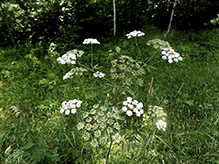 |
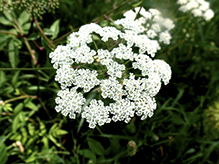 |
||||
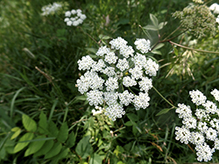 |
|||||
MinnesotaSeasons.com Photos |
|||||
Plant |
|||||
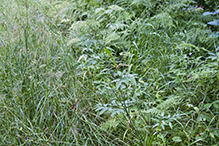 |
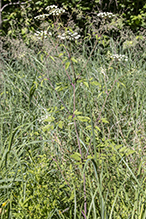 |
||||
Leaf |
|||||
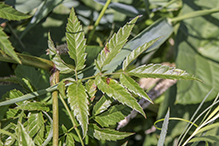 |
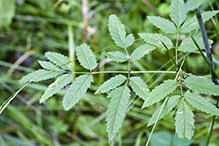 |
||||
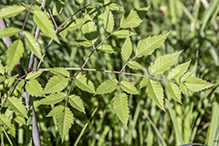 |
|||||
Stem |
|||||
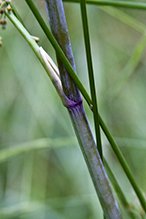 |
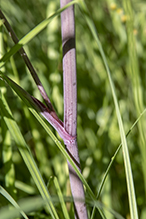 |
||||
Infructescence |
|||||
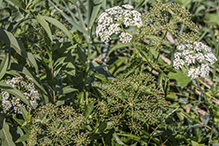 |
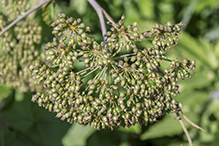 |
||||

Slideshows |
||

Visitor Videos |
|||
Share your video of this plant. |
|||
| This button not working for you? Simply email us at info@MinnesotaSeasons.com. Attach a video, a YouTube link, or a cloud storage link. |
|||
Other Videos |
|||
| water hemlock / spotted water hemlock (Cicuta maculata syn. C. curtissii, C. mexicana) UFInvasivePlantsEDU |
|||
About
Uploaded on May 20, 2010 Aquatic and Invasive Plant Identification Series by the UF/IFAS Center for Aquatic and Invasive Plants ( http://plants.ifas.ufl.edu ) and the Florida Fish and Wildlife Commission, Invasive Plant Management Section. For more information about water hemlock, go to http://plants.ifas.ufl.edu/node/99 Video editor/videographer - Phil Chiocchio |
|||

|
Created: Last Updated: © MinnesotaSeasons.com. All rights reserved. |
